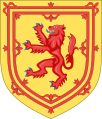Inboard
Inboard , even inboard is, in heraldry a name for a herald image , which in the real sense one from the edge of the escutcheon abgerückter board is.
For this representation different terms have been fixed in the description of the coat of arms . So it is an inner frame or just an inner frame . It is also called a collar , hem or parade . It is important that the tincture of the sign remains the same and is not changed by this "floating edge". If there is a change in color between inside and outside, the heraldist explains this figure as a double border . It is then emblazoned as a back shield , that is, a shield with a normal border rests on a second, larger shield. This interpretation of the heraldic image today has become uncommon, while the permissible expressions edge and (double) board or mount the unit stress of the shield.
The inboard can be changed by cuts and the use of heraldic figures (see more detailed board , with the same rules).
A twin inner border decorated with lilies on the outside and inside is found in the coat of arms of Scotland . The triplet inner shelf consists of three nested shelves, whereby the tincture of the individual inner shelves does not necessarily have to be the same.
Examples
in red a silver inboard ( by Randow )
in red a silver inboard ( half deck )
split; rear half inboard at the gap ( Balliol College )
A red double lily border in gold - a double inner border set with lilies alternating outwards and inwards ( Scotland )
one against ever having needled pine cones besteckter double rod inboard
See also
Individual evidence
- ↑ a b Gert Oswald : Lexicon of Heraldry. VEB Bibliographisches Institut, Leipzig 1984.
- ↑ a whole inboard was the coat of arms of the Scottish noble house Balliol





